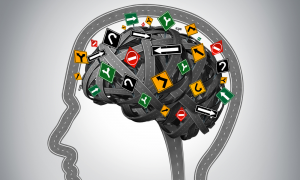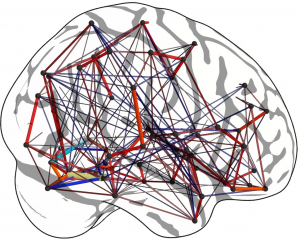by Sharon Duncan, Corin Goodwin, Joanna Haase, PhD, MFT, and Sarah Wilson
A collaboration of GHF: Gifted Homeschoolers Forum and GRO: Gifted Research and Outreach
An important but not well understood aspect of the gifted brain is connectivity, or the way the brain regions communicate among themselves. They can be observed in fMRI when functional connectivity captures brain interactions via fluctuations in an activity.1 Connectivity across brain regions is akin to the roads on which you travel to get from place to place. In the brain, these roads are made up of tracts of white matter which serve as higher speed freeways. The gifted brain has more of these tracts,2 allowing for the possibility of more “traffic movement.” While these studies may help to explain rapid processing and the ability to connect information that others cannot, just as in the real highway system, the brain sometimes experiences traffic jams, which slow down, or even halt, connections and thought processing. The integrity of white matter tracts play a role in information processing speed.3 While studies indicate a strong positive association between the global efficiency of brain networks and intellectual performance,4 it remains unknown how intellectual performance is related to the overall network architecture of our brain.

Why many gifted individuals are diagnosed with “slow processing speed” remains unclear. Slow processing speed could be the result of anything from how we measure processing speed, to how the white matter tracks become jammed like a freeway system at rush hour, or maybe even the integrity or efficiency of the white matter tracks themselves. Perhaps because children’s brains are works-in-progress, these information pathways may be developing asynchronously which may, at times, leave gifted individuals struggling to coordinate and communicate, as they trip over their own thoughts or words in conversation. To return to the highway analogy, different on-ramps may be operating at different speeds, leading to traffic jams and hold ups, inhibiting the gifted brain’s ability to process and move forward. The ability to connect information in different ways is both a hallmark of giftedness as well a one of the “signs” of attention deficit disorder. How do we know when the chaining of disparate ideas is leading to a unique idea (i.e., genius) or when it is actually difficulty staying on topic?
At other times gifted minds appear to end up chasing thoughts along different, tangential paths, diving through back alleyways and dashing over or under bridges. For example, a classroom instructor may ask the students a question about the number of watermelons in a station wagon. While the other students simply make mental or written calculations and then raise their hands to answer, the gifted child is—almost literally—somewhere else. They may have missed the question entirely because they were bored and daydreaming (providing the activation needed for good brain stewardship). They may find the question so absurdly simple that they are sure there is a trick that they have not yet figured out. They may consider an approach to the problem based on a different set of assumptions. Any of these possibilities could result in the gifted child beginning with the question and then moving on to try out those other connectivity tracts, following the watermelons to a story they read about cubed shaped watermelons in Japan, to a delicious melon-flavored infusion they tried last week, and somehow ending up pondering the price of tea in China. This thought process provides a great advantage for certain types of projects and creative thinking, but the classroom teacher responsible for a lesson to 35 students is unlikely to be especially interested.

Gifted people are also sometimes thought to have an exceptionally keen sense of the comical, bizarre, or absurd. In the brain, humor engages:
“. . . a core network of cortical and subcortical structures, including temporo-occipito-parietal areas involved in detecting and resolving incongruity (mismatch between expected and presented stimuli); and the mesocorticolimbic dopaminergic system and the amygdala, key structures for reward and salience processing.”5
In short, it involves an expected path of thoughts suddenly taking an unexpected turn. The gifted person with exceptionally greater connectivity across brain regions has more paths to follow, a potentially more rapid processing pace, and simply many more unexpected turns available.6 From the neuropsychological perspective, humor is an unexpected response or “punchline,” but humor can only work if two brains are in sync about the path to that point.7 When a profoundly gifted child shares what they believe to be a hilarious joke with a group of neurotypical children who don’t share their interests, the other kids may not be able to follow rapidly enough to see the connection and find the humor, thereby exacerbating the gifted child’s sense of isolation and alienation.8
Greater connectivity across the brain is another piece of the complicated puzzle of the neuroscience of the gifted brain. Anatomy, psychology, environmental factors, and other processes influence the behaviors manifested by gifted individuals. Next, we will investigate how and why the gifted brain acquires information at an accelerated rate. (find it here)
——–
- “Covariance and Graphical Models of Brain Connectivity,” Parietal, accessed June 24, 2018, https://team.inria.fr/parietal/18-2/spatial_patterns/covariance-and-graphical-models-of-brain-connectivity/.
- Francisco J. Navas‐Sánchez, Yasser Alemán‐Gómez, Javier Sánchez‐Gonzalez, Juan A. Guzmán‐De‐Villoria, Carolina Franco, Olalla Robles, Celso Arango, and Manuel Desco, “White Matter Microstructure Correlates of Mathematical Giftedness and Intelligence Quotient,” Human Brain Mapping 35, issue 6 (2014) accessed June 24, 2018: 2619-31. https://doi.org/10.1002/hbm.22355.
- L. Penke, S.M. Maniega, M.E. Bastin, M.C.V. Hernández, C. Murray, N.A. Royle, J.M. Starr, J.M. Wardlaw, and I.J. Deary, “Brain-wide White Matter Tract Integrity is Associated with Information Processing Speed and General Intelligence,” Molecular Psychiatry 17(10), October 2012, accessed June 24, 2018: 955. https://www.ncbi.nlm.nih.gov/pubmed/22996402?report=abstract.
- Martijn P. van den Heuvel, Cornelis J. Stam, René S. Kahn, and Hilleke E. Hulshoff Pol, “Efficiency of Functional Brain Networks and Intellectual Performance,” Journal of Neuroscience 298 (23), June 10, 2009, accessed June 24, 2018: 7619-7624. https://doi.org/10.1523/JNEUROSCI.1443-09.2009.
- Pascal Vrtička, Jessica M. Black, and Allan L. Reiss, “The Neural Basis of Humour Processing,” Nature Reviews Neuroscience 14 (October 30, 2013), accessed June 24, 2018: 860-868. https://www.researchgate.net/publication/258147630_The_neural_basis_of_humour_processing..
- Brock Eide and Fernette Eide, “Brains on Fire: The Multinodality of Gifted Thinkers,” New Horizons for Learning, December 2004, accessed June 24, 2018. http://archive.education.jhu.edu/PD/newhorizons/Neurosciences/articles/Brains%20on%20Fire/index.html.
- Rod A. Martin, The Psychology of Humor: An Integrative Approach, (Cambridge, MA: Academic Press, 2010): 5.
- Celi Trépanier, “It’s a Funny Thing: A Gifted Child’s Sense of Humor,” Crushing Tall Poppies, December 10, 2015, accessed June 24, 2018. http://crushingtallpoppies.com/2015/09/10/its-a-funny-thing-a-gifted-childs-sense-of-humor/.